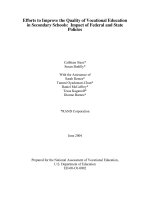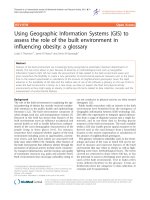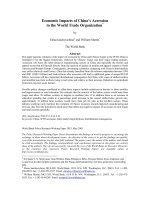CHINA’S EFFORTS TO SHAPE THE INFORMATION ENVIRONMENT IN VIETNAM - Full 10 điểm
Bạn đang xem bản rút gọn của tài liệu. Xem và tải ngay bản đầy đủ của tài liệu tại đây (4.96 MB, 90 trang )
September 2020
China’s Efforts to Shape the Information
Environment in Vietnam
Ryan Loomis and Heidi Holz
Approved for public release. Unlimited distribution.
IIM-2020-U-026222-Final
Abstract
The Chinese Communist Party (CCP) has embarked on a campaign to shape what audiences around the world read,
hear, and watch about China. This report is part of a series of reports that examine Beijing’s efforts to influence the
media environment in the neighboring Mekong countries—Laos, Cambodia, Myanmar, Vietnam, and Thailand. This
report focuses on China’s efforts to shape the information environment of its neighbor, Vietnam. In order to place
China’s efforts into context, this report begins by providing an overview of Vietnam’s information environment—the
aggregate of individuals, organizations, and systems that play a key role in shaping opinions through the
dissemination of news and information. Next, this report examines each of the ways that China attempts to shape the
information environment in Vietnam in order to promote its preferred narratives. This report concludes with a brief
discussion of issues to consider as Vietnam’s information environment—and China’s footprint there—evolves.
This document contains the best opinion of CNA at the time of issue. September 2020
It does not necessarily represent the opinion of the sponsor or client.
Distribution
Approved for public release. Unlimited distribution.
Cooperative Agreement/Grant Award Number: SGECPD18CA0027.
This project has been supported by funding from the U.S. Department of State.
Cover image credit: Shutterstock with modifications by Sue Mercer.
Approved by:
Maryanne Kivlehan-Wise- Director
China Studies Program
CNA China & Indo-Pacific Security Affairs Division
Request additional copies of this document through
Copyright © 2020 CNA. All rights reserved
Executive Summary
The Chinese Communist Party (CCP) has embarked on a campaign to shape what audiences around
the world read, hear, and watch about China. This report, which is part of a series that assesses
Beijing’s efforts to influence the media environments of the Mekong countries, focuses on China’s
efforts targeting audiences in Vietnam.
Key findings
China has had very little success shaping the media environment in Vietnam.
Beijing faces a hostile media environment in Vietnam that makes it difficult for it to promote
PRC narratives. In the words of one Vietnamese media expert, “They [China] are just not very
successful in getting their messages across.”
Government policies and regulations—in combination with a lack of public interest in PRC
propaganda—significantly restrict China’s access to Vietnam’s information environment.
Vietnamese media is highly critical of China on specific issues, likely due to a combination of
official propaganda guidance and anti-China sentiment. Vietnamese journalists and editors
avoid including interviews with Chinese officials.
PRC narratives fail to resonate among audiences in Vietnam due to widespread anti-China
sentiment. Historical Sino-Vietnamese conflicts and contemporary grievances make for a
hostile environment for Chinese media narratives.
China’s traditional tools for shaping foreign media have had little effect in Vietnam.
Nevertheless, there is evidence that China is attempting to shape the media environment in
Vietnam in the following ways:
Exporting Chinese-produced entertainment to Vietnam to bolster China’s “soft power”:
Chinese TV and film appear to be popular with Vietnamese audiences. They represent the
most successful aspect of China’s efforts to gain a foothold in Vietnam’s information
environment. However, only apolitical Chinese TV programs and films appear to have gained
popularity in Vietnam, as government censors and a China-critical public reject
entertainment that touches on politically sensitive subjects.
Producing Vietnamese-language news content: Several state-run PRC media outlets
produce content in Vietnamese, including China’s official overseas broadcaster, China Radio
International (CRI), and China’s official news agency, Xinhua. However,
CNA Information Memorandum | i
local audiences have increasingly shunned these PRC news outlets over the past decade, and
they have failed to secure substantial content-sharing agreements with Vietnamese
news outlets.
Seeking channels for distribution of PRC media content: Despite their efforts to achieve
greater cooperation with Vietnamese counterparts, PRC media outlets have had very limited
success to date—securing only one content-sharing agreement that is limited to English-
language news content.
Hosting training and cooperation forums in an effort to influence how the Vietnamese
media reports on China: Vietnamese central-level media officials have participated in China-
led international media forums and training programs such as the Lancang-Mekong Media
Cooperation Summit. However, their level of participation appears to be lower than that of
officials from other Mekong countries and there has been no observable softening of
Vietnamese media’s criticism of China.
The narratives that Beijing seeks to promote in Vietnam include the following:
China and Vietnam have a shared heritage.
China is willing to set aside its differences with Vietnam and pursue greater cooperation.
China is a more responsible and constructive international actor than the US, including in the
fight against COVID-19.
Issues to watch
As China continues to seek a presence in Vietnam’s information environment, key issues to watch
for in Vietnam include the following:
The appearance of more “Chinese voices” in Vietnamese media. Vietnamese media outlets
are reluctant to publish interviews with Chinese officials. Likewise, Vietnamese media outlets
publish few op-eds by Chinese officials compared to media outlets in other Mekong countries.
An increase in Chinese official op-eds and interviews observed in Vietnamese media would
indicate greater openness to China’s efforts to promote official narratives in the local media
environment.
Vietnamese media republishing PRC-produced content. Multiple PRC state-run media
outlets have sought increased cooperation with Vietnamese state-run media outlets, but have
thus far failed to achieve widespread republication of PRC media content by Vietnamese news
outlets. Of note, Vietnamese media does occasionally republish PRC media content in order
to criticize it. If Vietnamese media outlets begin to republish PRC-produced news content
without mocking it, this could allow Chinese narratives to reach a broader audience in
Vietnam.
CNA Information Memorandum | ii
Indications that Chinese entertainment is increasing in popularity. Although Chinese
historical dramas are popular in Vietnam, Chinese entertainment depicting contemporary
political issues does not appear to be. If such Chinese entertainment were to gain popularity
among local audiences, it would indicate a widening of Chinese media’s most successful
inroad into Vietnam’s information environment: entertainment.
An increase in anti-China reporting in Vietnamese media. Historically, Vietnamese
authorities have managed expressions of anti-China and anti-Chinese sentiment to keep the
domestic political situation and bilateral relations stable. In doing so, Vietnamese media
authorities typically greenlight criticism of China on maritime territorial disputes and
disputes over the Mekong River. It would be notable if Vietnamese media began to criticize
China on a broader range of issues. Such a shift could suggest that the Vietnamese
government had decided to take a harder-line stance against China.
Coordinated, inauthentic pro-China messaging campaigns on social media. Even though
Vietnam has enacted restrictions to online anonymity (i.e., the 2018 Cyber Security Law),
Chinese entities may step up efforts to promote and amplify pro-China messaging on
Vietnamese-language social media and online message boards, while attempting to conceal
the Chinese origins of these campaigns.
Recommendations from experts & media
professionals in the region
Vietnamese media professionals and experts offered suggestions about how the international
community could help to support the development of Vietnam’s media environment and its
continued resilience against PRC efforts to shape it. These included the following:
Provide journalism and media skills training. Vietnamese media professionals and experts
suggested that providing discrete skills training for journalists in partnership with the
Vietnam Ministry of Information and Communications (MIC) is likely the most successful
strategy for helping to support Vietnam’s media. Conversely, attempts to support broader
media development and/or promote Western journalistic norms would be unlikely to secure
the necessary official approval.
Coordinate with long-standing, trusted international partners. Several experts noted that
Vietnamese media officials are likely to view Western-based non-governmental
organizations (NGOs) and media training organizations with a critical eye. These experts
suggested collaborating with international organizations that already have an established
record of working in Vietnam as a way to improve access to the local information
environment.
CNA Information Memorandum | iii
CNA Information Memorandum | iv
Contents
1. Overview of Vietnam’s Information Environment......................................................................1
1.1 Introduction................................................................................................................................................................ 1
1.2 Background & key developments...................................................................................................................... 2
1.3 Key domestic media outlets ................................................................................................................................. 4
1.4 Key factors that shape Vietnam’s information environment ................................................................. 8
1.4.1 Regulations on press or individual freedoms of speech................................................... 8
1.4.2 Regulatory framework for managing foreign media actors......................................... 12
1.4.3 Foreign media presence and access to foreign media.................................................... 13
1.4.4 Diversity of foreign partners..................................................................................................... 15
2. China’s Efforts to Shape the Media Environment in Vietnam .............................................. 17
2.1 PRC narratives targeted at audiences in Vietnam ....................................................................................19
2.2 Tailoring PRC media content.............................................................................................................................20
2.2.1 Producing content in Vietnamese ........................................................................................... 20
2.2.2 Reporting on China’s activities in Vietnam ......................................................................... 24
2.2.3 Recruiting Vietnamese voices .................................................................................................. 26
2.3 Maximizing channels for distribution of China’s narratives ................................................................27
2.3.1 Providing content to Vietnamese media .............................................................................. 27
2.3.2 Jointly producing content with Vietnam media ................................................................ 31
2.3.3 Authoring opinion pieces for Vietnam media outlets..................................................... 35
2.3.4 Establishing a presence on social media in Vietnam ...................................................... 37
2.4 Attempting to influence Vietnamese media to promote China-friendly narratives...................39
2.4.1 Hosting international media forums and conferences................................................... 39
2.4.2 Hosting training and cooperation programs...................................................................... 41
2.5 Using entertainment to promote Chinese narratives..............................................................................44
2.5.1 Exporting Chinese-produced entertainment ..................................................................... 44
3. Assessing the Impact of Chinese Narratives...............................................................................48
3.1 Reach and resonance ............................................................................................................................................48
3.1.1 Widespread criticism of China in Vietnamese media ..................................................... 48
3.1.2 Critical views of China ................................................................................................................. 50
3.2 Issues to watch........................................................................................................................................................51
Figures .......................................................................................................................................................... 53
Tables............................................................................................................................................................ 54
Appendix A: China Radio International on Facebook ................................................................. 55
Appendix B: China’s Global Narratives ............................................................................................. 56
Abbreviations ............................................................................................................................................ 57
References................................................................................................................................................... 59
CNA Information Memorandum | v
CNA Information Memorandum | vi
1. Overview of Vietnam’s Information
Environment
Quick Country Facts
Literacy rate (2018): 95%1
Internet penetration (2018): 70.35%2
Mobile phone subscriptions (per 100
people in 2018): 1473
Total population (2020): 96,721,2754
Languages: Vietnamese (official), English
(favored as a second by at least 53% of
the population)5
UN Developing Country Status6
Source: CNA.
1.1 Introduction
The Chinese Communist Party (CCP) has embarked on a campaign to shape what audiences
around the world read, hear, and watch about China.7 In his report to the 19th Party Congress,
Chinese president and CCP General Secretary Xi Jinping voiced the aspirations of this
campaign, stating, “We will improve our capacity for international communication so as to tell
China’s stories well, present a true, multi-dimensional, and panoramic view of China, and
enhance our country’s cultural soft power.”8 This report is part of a series of reports that
examine Beijing’s efforts to influence the media environment in the neighboring Mekong
countries—Laos, Cambodia, Myanmar, Vietnam, and Thailand.
This report focuses on China’s efforts to shape the information environment of its neighbor,
Vietnam. In order to place China’s efforts into context, the report begins by providing an
overview of Vietnam’s information environment—the aggregate of individuals, organizations,
and systems that play key roles in shaping opinions through the dissemination of news and
information. Next, the report examines each of the ways that China attempts to shape the
information environment in Vietnam in order to promote its preferred narratives. The report
CNA Information Memorandum | 1
concludes with a brief discussion of issues to consider as Vietnam’s information
environment—and China’s footprint there—evolves.
1.2 Background & key developments
Vietnam’s media is state run. The Vietnamese party state, ruled by the Communist Party of
Vietnam (CPV), oversees all major media outlets and maintains tight control over their content
through a system of propaganda guidance and censorship. The government also mandates that
press outlets use information from the official Vietnam News Agency.9 The CPV exercises legal
authority over all print, broadcast, online, and electronic media, primarily through the Ministry
of Information and Communications under the overall guidance of the CPV Propaganda and
Education/Training Commission.10 The government works to ensure ideological alignment
by installing CPV members in news media management. Vietnamese law requires news
editors-in-chief to be CPV members (although, anecdotally, some editors in the south are not
CPV members); many outlets apply this requirement to other managers as well.11
Vietnam’s state-run media outlets function as mouthpieces of the CPV. As in other
communist countries, Vietnam’s state-run media complex serves as a propaganda organ of the
party state. News media communicate the party’s directives and priorities and seek to shape
domestic views to promote economic and social development and stability. 12 Critical voices
are given little, if any, space in the state-run media. Not only are newspaper editors-in-chief
required by law to be CPV members, lower-level editorial positions are also often filled by party
members. In 2018, for instance, Than Nien reportedly replaced 13 editors who were not CPV
members with active CPV members. These actions ensure a unified CPV message from
Vietnam’s key media.13
Social media has given the Vietnamese public greater space to exchange news and
analysis. Facebook and, to a lesser extent, the domestic social media platform Zalo are very
popular in Vietnam. According to a 2019 Pew research report, 91 percent of 18- to 29-year-
olds in Vietnam say they currently use Facebook, though only 23 percent of the country’s
50-and-older population uses the site.14 Free access to content from non-state run media
outlets and open discussion on social media attracted government scrutiny, which ultimately
resulted in the 2018 Cyber Security Law. Under the law, the government can prosecute
producers of online content for a broad range of offenses. Despite the threat of censorship,
fines, and arrest, social media—primarily Facebook—continues to serve as a popular
alternative source of news and information.15 Research by Pew in 2018 indicates that
81 percent of Vietnamese citizens between the ages of 18 and 29 get their daily news from
social media.16
CNA Information Memorandum | 2
Figure 1. CPV management of Vietnamese media
Source: Le Thu Mach and Chris Nash, “Social Media Versus Traditional Vietnamese Journalism and Social
Power Structures,” Asian Journal of Journalism and Media Studies, No.2, 2019, accessed Apr. 15, 2020,
/>
Vietnam has developed its own information and communication technology (ICT)
infrastructure. In addition to high internet penetration, provided at high speeds (compared to
neighbors) by more than 65 domestic internet service providers (ISPs), Vietnam is also rolling
out a domestically developed 5G nationwide network.17 Vietnam has deliberately chosen not
to rely on China or other foreign manufacturers for the newest generation of ICT upgrades,
choosing instead to develop its own infrastructure with the assistance of foreign partners from
a variety of countries, including Korea, Japan, India, China, Laos, Cambodia, the
United Kingdom, France, Slovakia, Hungary, and Iran.18 In addition to shunning Chinese
investment in domestic 5G upgrades, Vietnam has also carried out broadcast television
digitization upgrades using non-Chinese standards.19
CNA Information Memorandum | 3
Vietnamese citizens’ access to media is as follows:
Internet and social media. According to a 2019 survey, people in Vietnam spent a
daily average of 6 hours and 42 minutes using the internet.20 The Pew Research Center
reports that 48 percent of Vietnam’s online population uses social media as a source
for news at least once a day.21 Vietnamese social media users tend to be younger, more
educated, and wealthier than the general population. 22
Television. TV remains a popular source of news and entertainment.23 A 2019 survey
indicates that Vietnamese people spend a daily average of 2 hours and 31 minutes
watching TV (broadcast, streaming, and on-demand).24 According to reports by two
Vietnamese media and advertising organizations, broadcast TV accounts for 60 to
80 percent of advertisement spending in media.25 According to the most recent
Ministry of Information and Communications (MIC) statistics, as of 2017, Vietnam had
181 TV channels (103 free-to-air), 3 satellite digital TV service providers, and
5 terrestrial digital service providers.26
Radio. Low advertising spending on radio compared to internet and television
suggests it is less popular among audiences in Vietnam.27 According to the most recent
MIC statistics, as of 2017, Vietnam had 86 radio stations (77 free-to-air).28
Print. Print media in Vietnam is declining in popularity to the point that the
government is moving forward with an initiative to phase out most print media and
move newspapers to digital platforms.29
China has had very little success shaping the media environment in Vietnam. Beijing faces
a hostile media environment in Vietnam that makes it very difficult for it to promote PRC
narratives. Government policies and regulations significantly restrict China’s access to
Vietnam’s tightly controlled information environment. In addition, according to Vietnamese
media experts, many Vietnamese media professionals have internalized an anti-China bias that
is rooted in popular anti-China sentiment, as well as government censorship guidance. Because
of this, Vietnamese media is highly critical of China on specific issues. Finally, PRC narratives
fail to resonate among audiences in Vietnam because of widespread anti-China sentiment
among the general population. In the words of one Vietnamese media expert, “They [China] are
just not very successful in getting their messages across.”30
1.3 Key domestic media outlets
Vietnam’s central, provincial, and district governments each have their own media outlets.
Central-level mass media organizations include the Vietnam News Agency, Nhan Dan (the
People) newspaper, Vietnam Television (VTV), The Voice of Vietnam (VOV) radio, and the
CNA Information Memorandum | 4
newspapers run by the ministries and military. In addition, each province has at least three
media outlets: a newspaper, a broadcast station, and an online portal. Finally, each district runs
its own television station, which delivers information from the local government. Districts and
provinces also produce local programs for the upper-level journalism organizations.31 The law
requires at least 70 percent of Vietnamese radio and TV broadcasts to be domestically
produced content.32
Vietnam News Agency (VNA) is the most important media organization in Vietnam. According
to its website, VNA is a government agency that publishes and broadcasts official party and
state information.33 VNA runs more than 60 outlets, 30 overseas bureaus, and provides
domestic and foreign media outlets with news in Vietnamese, Chinese, English, French, and
Spanish.34 VNA offers print and digital newspapers in 10 languages: Vietnamese, Lao, Khmer,
Chinese, Japanese, Korean, Russian, English, French, and Spanish. VNA owns and operates
many domestic media outlets, including the following: 35
Thông tấn xã Việt Nam (TTXVN Vietnam News Agency Publishing House)
Tin Tuc (The News)
Vietnam News (English-language daily and “top foreign service publication”)
Vietnam Plus e-newspaper (accessed via vietnamplus.vn)
Thể thao & Văn hóa (sports & culture)
Vietnam Pictorial (a magazine for external services in 10 foreign languages; the only
Vietnamese paper published in Latin America)
Le Courrier du Vietnam (only French-language newspaper in Vietnam)
Vietnam Law & Legal Forum (issues English translation of Vietnamese legal bulletin,
Cong Bao)
Figure 2. VNA media outlets
Source: Vietnam News Agency Twitter, @VNAEnglish, accessed Apr. 23, 2020,
/>
CNA Information Memorandum | 5
VNA also runs television news programs on VNews TV channel, offered in English and Chinese
daily and in French and Spanish weekly.36 The tables below list other key local media actors in
order of popularity.
Table 1. Key online outlets by consumers
Name Type of Description Average daily reach Ownership
VnExpress media
Vietnamese- and English- 46 million regular FPT Group, a major ICT
Online, language online newspaper for users; 15.8 billion conglomerate. Editor-in-chief
digital politics, economics, finance, page views a year. Thang Duc Thang40
travel, and food. VnExpress 27,400 YouTube Under the Ministry of Science
publishes an average of 500 followers, 16,800 and Technology41
pieces daily.37 Twitter followers39
Describes itself as the “most
viewed Vietnamese
newspaper.”38
Yan News Online, Vietnamese-language online 17,206,278 Yan Media Group42
digital media outlet that produces Facebook followers
digital print and video content Vietnam Publishing association,
Zing News Online, news and entertainment for 151 million page under the Central Propaganda
digital young people in Vietnam. views per month43 and Education Department44
Vietnamese-language outlet 24h online advertising
24h Online, that covers breaking news, 8 million Facebook corporation45
Source: CNA. digital lifestyle, sports, economics, followers
world news, and technology.
Tabloid news and
entertainment.
Table 2. Key television outlets
Name Type of Description Average daily Ownership
media reach* Vinh Long Province
THVL1 Free-to-air Vinh Long Province’s 3,008,992 daily
(TH Vinh television television station, news and viewers
Long 1) entertainment.
(HTV7) TH Free-to-air 1,905,377 People's Committee of Ho Chi Minh
Ho Chi television General entertainment. daily viewers City46
Minh 7
Free-to-air Vietnam’s original television 1,904,605 daily Government of Vietnam
VTV1 television station, now an all-news viewers
channel.
Source: CNA.
*Average daily reach according to 2019 Nielsen data
CNA Information Memorandum | 6
Table 3. Key domestic actors: radio
Name Type of Description Average daily Ownership
media reach
Voice of National broadcaster, with nationwide Vietnamese government
Vietnam Radio stations and broadcasts including news, Available
music, and entertainment. Has two 24/7 nationally, Under the administration of
(VOV) English frequencies and broadcasts short broadcast by the Ho Chi Minh City Service
segments in 12 languages (including a provincial of Culture and
daily one-hour Chinese segment).47 VOV stations Communication, HCMC
Communist Party
Voice of Radio Communicates the standpoint of the Limited to Commission49
HCMC party, the state, and the city to all southern
(VOH) citizens.48 Vietnam
Source: CNA.
Table 4. Key domestic actors: newspapers
Name Type of Description Average daily reach Ownership
media
Hồ Chí Minh
Covers education and culture, 500,000 copies per Communist Youth
Union51
Tuổi Trẻ Newspaper, business, economic reforms, day50
print, and social welfare, health, 2.4 million Facebook Official tribune of
environmental issues, Vietnam’s Youth
online unemployment, urban followers Association53
404,000 YouTube
Owned and
development, and lifestyle. subscribers operated by the
CPV
300,000 copies per
Operates under
Newspaper, Official news and information on day52 the management
and oversight of
Thanh print, and politics, social, economic, 1.8 million Facebook VNA58
Niên
online education, culture, sports, and followers
opinion pieces. 2.25 million YouTube
subscribers
“Central Organ of the Communist 220,000 copies per
Newspaper, Party of Vietnam” and “The Voice day56
Nhân Dân print, and of the Party, State and People of 18,000 Facebook
54
online Vietnam” Available online in followers
English, Vietnamese, and 1.2 million YouTube
Chinese.55 subscribers
English-language daily
newspaper, publishes seven days Circulation unknown
Vietnam Newspaper, a week in print and maintains 23,649 Facebook
News
print, and online news portal. Covers followers
online domestic and international news, 35,000 YouTube
socioeconomic issues, and subscribers
sports.57
Source: CNA.
CNA Information Memorandum | 7
1.4 Key factors that shape Vietnam’s
information environment
Several factors shape Vietnam’s information environment. These include the following:
Regulations on press or individual freedoms of speech
Regulations on foreign actors in the domestic information environment
Foreign media presence and availability
Diversity of foreign partners who can assist with deficits in media content, training,
or infrastructure
1.4.1 Regulations on press or individual freedoms of speech
Vietnam currently ranks very low in terms of press freedom. France-based Reporters sans
Frontières (RSF) ranked Vietnam 176 out of 180 countries on its World Press Freedom Index,
noting that “all Vietnamese media follow communist party orders, and the only source of
independently-reported information are bloggers and citizen journalists, who are subject to
ever-harsher persecution [such as] plainclothes police violence.”59 In October 2019, The
Committee to Protect Journalists (CPJ) ranked Vietnam as one of the 10 most censored
countries on earth (at number 6). Vietnam’s “raft of repressive laws and decrees,” it wrote,
“sharply [curtail] any media criticism of the one-party government, its policies, and its
performance” via digital technologies.60 Likewise, Freedom House scores Vietnam 1 out of 4 for
free and independent media.61 The Vietnamese government uses the following tools to manage
the media:
Party guidance
Laws and regulations
Control over the allocation and renewal of print and broadcasting licenses
Censorship
Encouragement of self-censorship
Party guidance
At the highest level, the CPV’s Central Propaganda and Education Commission (CPEC) works
together with the government’s MIC to ensure that all of the nation’s media conforms to party
guidance.62 As noted previously, news editors-in-chief are legally required to be CPV members
and all journalists must be party accredited.63 Vietnamese journalists interviewed by Al Jazeera
CNA Information Memorandum | 8
have confirmed that they signed papers affirming that their jobs included protecting the
country in addition to being journalists.64
Media Development and Management Plan Until 2025
In April 2019, Prime Minister Nguyen Xuan Phuc approved a plan for developing and
managing Vietnam’s national press through 2025. According to Nhan Dan, the official
mouthpiece of the Communist Party of Vietnam, the objective of the plan is to reduce
redundancy within the press system and improve multimedia capabilities within the six
major media outlets and agencies of the national press system: VNA, VOV, VTV, People’s Army
Newspaper, People’s Public Security Newspaper, and Nhan Dan. The plan emphasizes the
development of modern multimedia capabilities, while maintaining State and Party control.
The main points of the plan can be summarized as follows:
To reaffirm that the press is an important means of communication, propaganda, and
thought for Party and State, under the direct and comprehensive leadership of the
Party.
To develop the media in line with modern information needs, intellectual and
cultural development, while propagating the Party’s positions, policies, and laws.
To adopt state and market financial mechanisms and policies that create the
conditions to allow media to serve its political purpose and not be driven by profit,
nor allow private ownership or interest groups to dominate the press.
To securely develop journalism and media in line with the trends of science,
technology, and modern information and communication development.
Source: “Press Development Planning until 2025 Approved,” Nhan Dan, Apr. 4, 2019, accessed Sep. 1, 2020,
/>vietnam?PageSpeed=noscript; “Approval of the national press development and management planning until
2025,” (QUYẾT ĐỊNH: Phê duyệt Quy hoạch phát triển và quản lý báo chí tồn quốc đến năm 2025), Ministry of
Information and Communication, Apr. 4, 2019, Decision No. 362-QĐ/TTg, accessed Sep. 1, 2020,
/>
CNA Information Memorandum | 9
Laws
The Vietnamese party state governs its media through a system of strict laws and regulations.
Key laws are described in Table 5.
Table 5. Key media laws
Law Description Key articles
1999 Law on 2006 Decree – Defines 200 additional
Media
The law states that, “the State is to violations in culture and information.66
organize information for the media 2011 Decree – Restricts the use of
and manage the information of the pseudonyms and anonymous sources.
media;” and the “press is prohibited Also excludes bloggers from press
from reporting on information that protections.67
could be considered ‘untruthful, 2013 Decree – Prohibits sharing
distorted, or slanderous and harmful’ “compiled information” on social
to an individual or organization.” 65 media.68
The law states that the press must Article 88 – Bans dissemination of anti-
government propaganda.
serve as the voice of the party, party Article 79 – Ban on activities for
organizations, and state agencies.
overthrowing the state.
Censorship is enforced through
2016 Press Law government directives to newspaper, Article 258 – Prohibits the “abuse of
2018 Cyber radio, and TV editors, commanding democratic freedoms” to undermine
Security Law
topics that are to be highlighted and state interests.70
omitted.69
Regulates technology companies that The law bans people from using online
operate in Vietnam, mandates platforms to “insult great men, national
companies to store information leaders, historical figures, and national
about Vietnamese users in Vietnam, heroes,” to “distort history, undermine
making it accessible to state national solidarity, or to disseminate
authorities, and restricts the Internet untrue information that stirs
connections of users who post obfuscation among the people.”72
“prohibited” content.71
Source: CNA.
State-run media outlets have been punished for violating these laws. In 2018, Vietnam's MIC
announced that the state-run Tuoi Tre newspaper would be suspended for three months and
fined 20 million dong (US $10,000) for a June 2018 report that authorities said “misquoted
President Tan Dai Quang endorsing a law on public demonstrations.”73
CNA Information Memorandum | 10
Licensing
The MIC is in charge of licensing for media outlets. The MIC is the policymaking and regulatory
body for the press, publishing, post, telecommunications, radio frequency, information
technology, electronics, broadcasting, media, foreign information, domestic information,
national information and communication infrastructure, and management of related public
services on behalf of the government. The MIC’s functions, duties, and responsibilities are
outlined in Government Decree No. 17/2017/ND-CP, dated February 17, 2017.74 According to
MIC statistics, there are more than 65 licensed ISPs in Vietnam.75
Censorship
Propaganda officials require editors of major media outlets to meet regularly to discuss topics
that are off-limits for reporting. CPEC and the MIC convene these meetings in Hanoi to review
media activities conducted during the previous week, and deliver guidance on topics to be
reported on in the coming week.76 The MIC and the military both play a role in domestic online
censorship. In December 2017, the military unveiled a 10,000-strong military cyberwarfare
department called “Force 47,” which is tasked with defending the Party and targeting dissident
bloggers.77 There have been reports that Vietnamese authorities responsible for internet
censorship have coordinated with Chinese counterparts.78
The MIC also restricts online advertising funding for content it deems “anti-state,” in an
attempt to further censor the online media environment. In 2019, the MIC’s Authority of
Broadcasting and Electronic Information told dozens of brands to pull their ads from YouTube
videos that contain “anti-state propaganda.” The request was made after the MIC reported the
reoccurrence of advertising attached to videos containing illegal and malicious content. The
list of offending firms included Huawei Technologies Co. Ltd.79
Self-censorship
Self-censorship is reportedly pervasive in Vietnam, including among independent journalists
and bloggers, because of the threat of dismissal and possible arrest. The government has
punished journalists for failing to self-censor, including by revoking press credentials.80 In
November 2018, for instance, the CPV publicly denounced Chu Hao, then-director and editor-
in-chief of the Tri Thuc Publishing House, for “disobeying the Party’s regulations” and “self-
evolution.” Hao, a former vice minister of science and technology and a prominent intellectual,
had directed Tri Thuc to publish books with themes of freedom and democracy, which the CPV
inspection body said indicated Chu Hao’s “degeneracy in political thought, ethics and lifestyle.”
Hao left the CPV and, as a result, lost his position at Tri Thuc.81
CNA Information Memorandum | 11
1.4.2 Regulatory framework for managing foreign media actors
Foreign media is highly regulated in Vietnam. Key aspects of government regulation include
the following:
Foreign media must obtain licenses to operate in Vietnam. The MIC can revoke the
licenses of foreign publishers; and foreign publishers must renew their licenses annually.82
According to the Associated Press (AP), foreign media representatives are allowed to live
in Vietnam but are subject to restrictions on where they can travel and what they can
report.83
The government controls visas for foreign journalists. Major foreign media outlets have
reported that the government delayed or refused to issue visas for reporters who
previously covered sensitive political topics, particularly reporters for the overseas
Vietnamese-language press. 84
Regulations limit the number of foreign broadcast channels. According to MIC
regulations, the number of foreign channels included in a paid radio or television service
package “will not account for more than 30 percent of the total number of channels.” 85
Regulations limit the volume of foreign-produced broadcast content that can be aired
domestically. According to a report in the state-run Vietnam News, the MIC asks radio and
television stations to ensure that 70 percent of programs are domestically produced and
only 30 percent are foreign.86 The law requires “live” foreign television programming to
run on a 30- to 60-minute delay to enable content monitoring. 87
Foreign broadcast content must be translated by state-approved translators. Foreign
channels must be translated into Vietnamese by an organization that is licensed to edit
foreign broadcasting channels and has an authorized agent in Vietnam to fulfill its financial
obligations under Vietnamese regulations. 88 The MIC appears to be on track to amend
Decree 6 on Broadcasting and TV Services to regulate on-demand content in a way that has
raised concern by foreign media companies because of additional translation and editing
requirements, prohibition of pre-installed advertisements, and other licensing hurdles. 89
Foreign channels are not allowed to broadcast foreign-produced advertisements.
Regulations require that foreign channels must not broadcast advertisements from abroad.
Advertising content must be prepared in Vietnam, edited by a government-licensed unit,
and comply with Vietnamese advertising law.90
Foreigners cannot be majority owners of domestic telecom companies. Vietnamese law
prohibits majority ownership of facilities-based basic telecom companies. The law states
that foreign investment in facilities-based basic telecom services is possible through
licensed telecom service providers. However, foreign capital contributions cannot exceed
49 percent of legal capital in the joint venture. For non-facilities-based basic telecom
CNA Information Memorandum | 12









